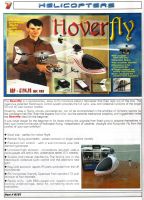Snelflight
Snelflight Hoverfly II
Small British company from Hampshire came up with a novel way for learning, the umbilical cord was not new as the Ishimasa Skylark of many years earlier has used that method for powering the system. What was different was that it actually was NOT radio controlled though it did use a normal RC transmitter. The electronic module was 'slaved' to the 'trainer' socket on the transmitter and these signals were fed through the umbilical to the helicopter. The rotor was free rotating and with the motors running would wind up to about 250 RPM. It was effectively a 'Fixed pitch' machine as height control was achieved by varying the speed of the motors however, cyclic control was effected by varying the motor speed at pre-determined positions thus tilting the rotating assembly in the required direction.
Because the rotor was free running the torque reaction from the electric motors was balanced by the assembly rotating. An electric tail rotor was fitted however though it was normally stationary and only used to change direction or counter any sudden swing due to rapid throttle movement. In a stable hover or with slow throttle movement the tail was very controllable however, it would swing about with over enthusiastic throttle control so in order to aid learning and provide a measure of extra stability an option tail gyro was available. One additional benefit was that as the power was supplied from a mains transformer there was no limit (except transmitter battery) to the time spent learning to fly.
Once hovering then it reacted very similar to a 'normal' helicopter however, It did require a special technique to achieve a smooth lift off into the hover. Because of gyroscopic precession, when in contact with the ground if a sideways cyclic control was inputted the helicopter would actually tilt forwards or backwards. Additionally, if the throttle was opened too quick and the rotor has not started rotating then it became unstable when lifting off with cyclic control having no affect. The trick was to open the throttle reasonably slowly in order to allow the rotor to start rotating then just as it became 'light' on the skids and before it could tilt the throttle was sharply opened to the hover position. It then hoped up nice and stable with the rotor spinning fast enough for good control whilst it sped up to match the hover throttle setting; additionally, if you had a gyro fitted then it stayed nice and straight.
One final note; although it acted very similar to a helicopter with a 'normal' configuration and the advert below plays heavily on this description, it could bite and badly. Cyclic control was fairly progressive but if you got a bit enthusiastic in doing fast tight figure eights it would reach a point when it sort of seemed to 'slip' sideways (best description I can think) which requires a large counter correction which then causes it to 'drop' out of the sky so to speak.
Hoverfly manual - Not much building but MUST be set up properly.
| Click for advert from 2001 extolling the virtues of the Hoverfly |
Note that a lightweight Cobra fuselage was provided to give it a scale look.
Info files for common questions / problems:-
Learning - Reasons for choosing the Hoverfly and setting up info.
Umbilical - Why an umbilical?
Wobble - What to do when the infamous helicopter 'wobble' occurs.
Bought two of these in May 08 and managed to make one good one out of the two; interesting flying characteristics.
Snelflight Chinook
E-bay purchase and not had a chance to check it out yet; no info held at the moment on this model.





